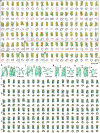Non-averaged single-molecule tertiary structures reveal RNA self-folding through individual-particle cryo-electron tomography
- PMID: 39433544
- PMCID: PMC11494099
- DOI: 10.1038/s41467-024-52914-1
Non-averaged single-molecule tertiary structures reveal RNA self-folding through individual-particle cryo-electron tomography
Abstract
Large-scale and continuous conformational changes in the RNA self-folding process present significant challenges for structural studies, often requiring trade-offs between resolution and observational scope. Here, we utilize individual-particle cryo-electron tomography (IPET) to examine the post-transcriptional self-folding process of designed RNA origami 6-helix bundle with a clasp helix (6HBC). By avoiding selection, classification, averaging, or chemical fixation and optimizing cryo-ET data acquisition parameters, we reconstruct 120 three-dimensional (3D) density maps from 120 individual particles at an electron dose of no more than 168 e-Å-2, achieving averaged resolutions ranging from 23 to 35 Å, as estimated by Fourier shell correlation (FSC) at 0.5. Each map allows us to identify distinct RNA helices and determine a unique tertiary structure. Statistical analysis of these 120 structures confirms two reported conformations and reveals a range of kinetically trapped, intermediate, and highly compacted states, demonstrating a maturation folding landscape likely driven by helix-helix compaction interactions.
© 2024. The Author(s).
Conflict of interest statement
The authors declare no competing interests.
Figures










References
-
- Yip, K.M. et al. Atomic-resolution protein structure determination by cryo-EM. Nature 587, 157–161 (2020). - PubMed
Publication types
MeSH terms
Substances
Grants and funding
- R01GM104427/U.S. Department of Health & Human Services | NIH | National Institute of General Medical Sciences (NIGMS)
- DE-AC02-05CH11231/DOE | SC | Basic Energy Sciences (BES)
- R01 DK042667/DK/NIDDK NIH HHS/United States
- R01 HL115153/HL/NHLBI NIH HHS/United States
- R01 MH077303/MH/NIMH NIH HHS/United States
- R01MH077303/U.S. Department of Health & Human Services | NIH | National Institute of Mental Health (NIMH)
- R01DK042667/U.S. Department of Health & Human Services | NIH | National Institute of Diabetes and Digestive and Kidney Diseases (National Institute of Diabetes & Digestive & Kidney Diseases)
- 683305/EC | EU Framework Programme for Research and Innovation H2020 | H2020 Priority Excellent Science | H2020 European Research Council (H2020 Excellent Science - European Research Council)
- R01 GM104427/GM/NIGMS NIH HHS/United States
- R01HL115153/U.S. Department of Health & Human Services | NIH | National Heart, Lung, and Blood Institute (NHLBI)

